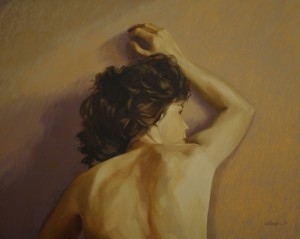Dear Artist,
Art historian Jack Flam wrote a book about the relationship between Matisse and Picasso. It’s useful reading for any artist who has a close and competitive friend in the same business.
Matisse and Picasso were strikingly different, both as artists and individuals. Matisse, older by eleven years, was prissy compared to the rascally Picasso. Picasso’s approach to art tended to be literary. His works were generally based on the imagination and centered on a particular idea. Matisse, on the other hand, developed his work from observation — the colour of things, patterns, graphic relationships. He was also easily distracted — he sometimes threw in everything that came his way.
Picasso’s work was often pregnant with aggression — Matisse’s work was diffused with what he thought was “balance, purity and serenity.” At the same time they were both motivated and turned on by primitive art, Cezanne, women, and their own egos. Both artists avoided full abstraction yet built their art around a personal view of reality. Each borrowed both spirit and directions from the other while remaining true to his own artistic temperament.
One might conclude that while personalities may clash and aggravate, intelligent rivals learn to respect one another’s turf and relish one another’s success. They know there is enough to go around. They take the trouble to understand and protect both their unique and mutual sources.
In their small worlds they are able to see the bigger picture and turn rivalry to advantage. While they may get on each other’s nerves, they know that tension, jealousy and anxiety are negative feelings that can eat at a creative soul.
Stellar connections can have the effect of driving creators toward even more uniqueness. Artists can be thankful when they are blessed with the gift of rivalry — it can be the basis for personal excellence and, in the long run, the makings of the best kinds of friends.
Best regards,
Robert
PS: “What made these two artists, Matisse and Picasso, so good — part of the answer is ‘each other.’ ” (Rebecca Tuhus-Dubrow)
Esoterica: Matisse and Picasso: the Story of their Rivalry and Friendship, by Jack Flam, describes the effect of the nearby presence of stardom. Picasso, with his remarkable energy and appetite, takes on celebrity status. In front of Matisse he becomes the auteur of idiosyncratic art and lifestyle. Matisse, in the shadow perhaps, quietly opens the way to future art.
This letter was originally published as “Rivalry and Friendship” on May 2, 2003.
Download the new audio book, The Letters: Vol. 1 and 2, narrated by Dave Genn, here. Proceeds of sales contribute to the production of The Painter’s Keys.
“Hatred, rancor, and the spirit of vengeance are useless baggage to the artist. His road is difficult enough for him to cleanse his soul of everything which could make it more so.”(Henri Matisse)
Featured Artist
My aim as a painter is to bring to life a slice of the world as I experience it. Light, color and form are my vocabulary.










7 Comments
great article as usual ! as I read it rivalry moderated by a healthy respect serves to extend the boundaries of creativity and leaves a legacy of excellence in art – there is enough for everybody- well written,
mary
http://www.pixi-art.com
“While they may get on each other’s nerves, they know that tension, jealousy and anxiety are negative feelings that can eat at a creative soul.” This observation Robert makes is often times noticed in today’s “art circles”: especially tension and jealousy. It would be ideal if: “intelligent rivals learn to respect one another’s turf and relish one another’s success.” I like that! Thank you for posting Robert’s letter from May 2003. There is so much to learn from him.
If you saw those images at a local Sunday morning amateur art show you wouldn’t give them a second glance. Just too easy. But I know someone is going to say ‘that is the beauty of them’….
Both Matisse and Picasso were trained artists-take a look at their very early works. They had the knowledge and ability to go beyond the boundaries of tradition. There is a big difference between an amateur, who is not trained, not knowledgable and is just making paintings for a Sunday morning show, and working trained artists who can back up their work. “You have to know the rules to break the rules.”
Dear Nonie…I’ve studied the work of both of these artists extensively…they just got lazy. What you are saying I’ve heard a thousand times before. By all means break the rules but at least improve on them in some way. These paintings are simply visually uninteresting. Do they seriously hold YOUR attention?…If they do then there is probably not a lot more to be said.
Funny story: Jascha Heifetz, the great violinist, was an admirer of Ansel Adams. He visited Adams out west, and in the course of their conversations, kept expressing a great deal of interest in how much Ansel had paid for each of the cameras and other items that he used to create such beautiful photographs, as if the cost might have something to do with the outcome. After his visit, Heifitz invited Adams to come to New York to hear him play at Carnegie Hall. Adams accepted the offer, and when the concert was over, went backstage to greet his new friend. The first question he asked was, “So Jascha, how much did you pay for that violin?”
Are we talking older Picasso and Matisse? Sounds like a good book to peruse.